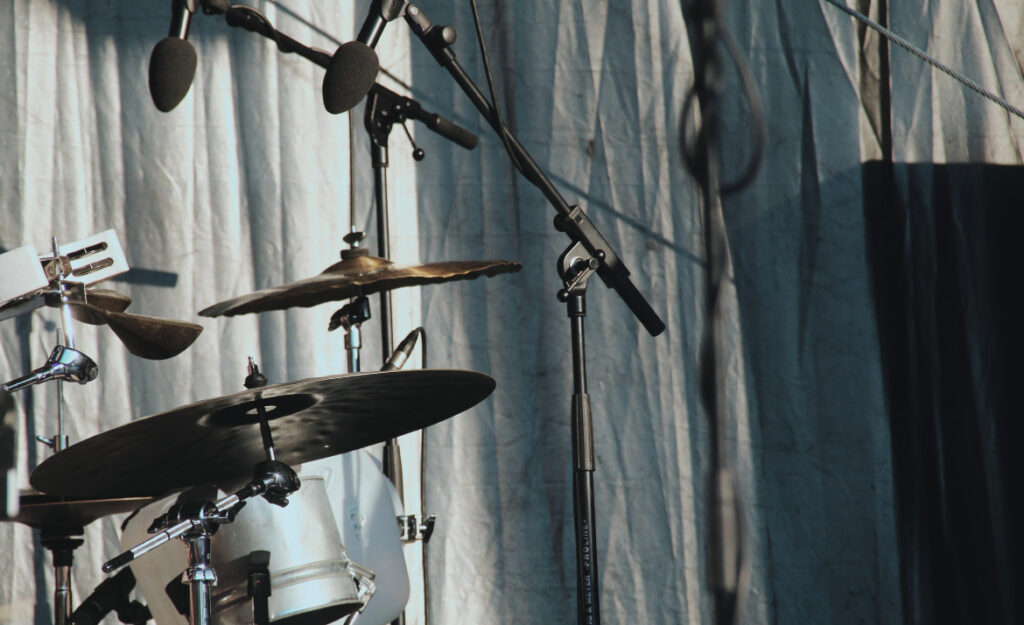When a song’s drums sound lifelike and immersive, it’s easy to forget someone made careful choices behind the scenes. People talking about drum recording always mention overhead mic techniques, and for a good reason—they shape the whole kit’s sound.
For drummers, engineers, or anyone recording at home, the difference between a dull track and an inspiring one can lie in overhead choices. These techniques affect clarity, depth, and punch from the first hit to the final mix.
This guide shows how overhead mic techniques can pull that elusive “natural drum tone” from any kit. Explore proven setups, actionable tips, and specific real-world examples to upgrade your sound.

The Starting Point: Placing Overheads to Emphasize Kit Balance
Certain placement rules always lead to more musical results when setting up overheads. Start simple: always stand where your head is likely to be while playing and listen—this is your “reference position.”
Aim to capture the entire kit’s voice, not just cymbal wash or snare crack. The goal is a clear, balanced drum mix that feels like standing behind the kit. This makes the overheads the backbone of your drum sound.
Minimizing Phase Problems During Initial Setup
Walk slowly around the kit with a mic held at head height. Notice the snare’s center image and whether toms and cymbals feel evenly present in both ears. Where the sound feels unified, set your first mic.
Tilt the mic slightly off-axis if crashes feel harsh or washy. Small angle changes—five or ten degrees—significantly change cymbal brightness and resonance while capturing a truer kit picture overall.
Avoid aiming directly at the ride bell, as it can spike high frequencies. Instead, angle the mic between toms and hats for a more controlled balance—even when hitting crash cymbals with force.
Distance and Height Affecting Tone and Image
Measure the height above the snare, commonly between 40–48 inches. If a mic is lower, toms and cymbals sound closer and more aggressive. Higher placements yield softer, wider ambient sounds.
Work in pairs: place both overhead mics exactly the same distance from the snare’s center. Use a cable or tape measure for accuracy—this maintains the drum attack in the stereo image and avoids comb-filtering.
If the kick drum feels buried or lost, lowering both mics by two to four inches recovers punch without muddying the cymbals. Always let your ears decide, but let measurements guide your starting point.
| Mic Placement | Height Range | Resulting Tone | Ideal Scenario |
|---|---|---|---|
| X/Y Stereo | 42 inches | Cohesive, mono-compatible | Small rooms, limited mics |
| Spaced Pair | 48 inches | Wide, roomy | Big, live rooms |
| ORTF | 43 inches | Natural, focused | Jazz, acoustic projects |
| Glyn Johns | 40–46 inches | Lively, present | Vintage rock |
| Mono Overhead | 45 inches | Tight, direct | Lo-fi, minimal setups |
Fine-Tuning Overhead Angles and Orientation
Fine-tune mic angle and orientation to control drum and cymbal relationships. Each orientation addresses specific frequency and stereo field needs, making them essential tools for engineering creative balance.
Position the mics so their capsules point slightly inward, not straight down. This softens harshness and stops the crashes from dominating your overhead tracks while maintaining kit definition.

Drum Kit Miking Techniques That Transform Small Performances
Learn proven mic choices, placement routines, and troubleshooting steps to get your drums clear, punchy, and always in the groove.Small Moves: Angle Adjustments Yield Big Changes
Rotate each mic five degrees left or right to narrow or widen the stereo image. If hi-hats are too sharp, angle the closest mic away by about 10 degrees to smooth it out.
- Angle to tame hi-hat bleed
Turning the mic away from the hats emphasizes toms and cymbals without harshness. Use your hand as a test screen to block off-axis bleed during setup. - Point mics toward the snare center
This brings the snare into the central stereo “sweet spot.” Measure distances again to keep phases locked and transients clear. - Avoid direct alignment with the ride bell
Directly facing the bell produces an unnatural ping; an off-axis angle provides lushness and depth that sounds more musical. - Tilt for cymbal variety
Angle one mic towards a crash, the other toward the ride. You’ll capture a nuanced stereo image while balancing frequency content side to side. - Experiment with “overhead tilt”
Raise one side an inch or two for slightly more width and air. This method is excellent when tracking large kits with many cymbals.
Be deliberate with each angle change. Tiny adjustments often outperform big ones, granting refined control over a kit’s stereo field and fullness.
Capturing the Kit’s Personality With Capsule Height Variations
- Lower for aggression
Set the mics at 38–40 inches for more transient attack, important for metal or fast rock tracks where punch outranks ambience. - Raise for space
Bump to 48 inches for a more open, natural room sound, suited to jazz, indie, or crisp funk grooves. - Compensate for room size
In tight rooms, lower positions curtail unwanted reflections. In big rooms, height adds desirable liveliness and space. - Match heights precisely
Always check both mic capsules are level—it prevents phase issues and ensures drum attacks remain tight through speakers or headphones. - Time-align if needed
When one mic can’t move, delay the other by a handful of samples in your DAW. Match initial snare hits visually for improved stereo impact.
Accurate height adjustments guarantee each drum hit feels intentional rather than lost or bloated in the mix.
Clever Patterns: Exploring Popular Overhead Setups
Trying different overhead mic techniques is the fastest way to find what fits your musical style. Each uses unique spacing and angle rules to highlight the drum kit’s strengths.
Direct your energy at testing several classic approaches, editing them to fit your room, drum sizes, and preferences. The balance between punch and spread sets the foundation for a mix that feels natural, not forced.
X/Y Coincident Stereo for Mono Compatibility
Set two small diaphragm condensers close together at a 90-degree angle, their capsules nearly touching. Place this directly above the snare at 42 inches for a crisp, phase-coherent sound with excellent mono translation.
X/Y saves desk real estate and is reliable in tricky rooms. The tight stereo image still lets cymbals shimmer while the snare stays locked in the center of your mix.
If you want a kit sound that never disappears in a complex pop production, X/Y makes a perfect, punchy backbone for layering extra room or spot mics without fuss.
Spaced Pair for Wide Roomy Sound
Place each mic about 32–38 inches apart, lining up directly over the first and last tom. Ensure equal vertical and horizontal spacing from the snare to prevent flanging or lost center image.
Spaced pairs are popular in rock and jazz thanks to their sense of width and realism. Pan hard left and right, and you’ll hear a “centered” snare with huge, open cymbals.
If your room sounds great live, try this setup. Just remember: always measure for phase alignment to dodge the classic “hollow snare” issue, especially on big hits.
Crafting Depth: Blending Overheads With the Rest of the Kit
Blending overhead mic techniques with close-mics produces a realistic sense of room. Focus first on balancing snare and kick within the overheads before mixing spot mics for detail or extra attack.
Adjusting overheads’ fader level changes perceived kit size. Pull overheads up for an “all-at-once” sound or lower them to feature close-miked snare and kick for modern pop or hip-hop.
Actionable Workflow for Mixing Overhead Tracks
Start with overheads soloed, moving their faders up until the kit sounds like you’re standing a few feet away. Add close snare and kick mics at low volume first, checking alignment visually and by ear.
If the kit sounds “off-center,” adjust panning slightly left or right. Increase spot mic level only if tom fills or accents need clarity for complex parts.
Mute everything except overheads and room mics when dialing in reverb. This prevents cymbals from becoming washy and keeps your mix punchy, especially when drummers play aggressively.
Choosing the Right Overhead EQ and Compression Settings
Gently roll off lows below 120 Hz to clear out unnecessary rumble. Boost or cut between 7–12 kHz for crispness, but only in small increments—drums can sound artificial when over-EQ’d.
Add mild compression, 2:1 or 3:1 ratio, with the threshold set so gentle cymbal hits trigger light gain reduction. Fast attacks tighten up transients, while slower releases retain natural decay.
If you notice harshness or “sizzle,” back down high-shelf EQ or try a dynamic EQ. Always aim for a balanced, open sound rather than “exciting” the mics into harsh territory.
Overcoming Real-World Challenges With Smart Overhead Placement
Challenges like low ceilings, small rooms, or noisy environments can skew a recording’s balance. Strategic placement and gear choices let you achieve great overhead mic techniques in less-than-ideal conditions.
Move overheads closer to the kit to minimize reflections, but never block the drummer’s movement. Use dynamic mics for louder rooms where condenser brightness highlights flaws instead of detail.
Mitigating Small Room and Ceiling Issues
Position mics slightly to the drummer’s left and right, not directly overhead, to avoid slap-back from ceiling panels. Angle the capsules downward but toward the front edge of the snare for clarity, keeping them 6–12 inches below ceiling height.
Heavy carpets and foam paddings in front of the kit absorb excess high-frequency bounce. “Deadening” a corner behind the drummer gives a firmer, less ringing kit sound on overheads.
Pointing the overheads toward the floor instead of parallel to ceiling tiles can eliminate that telltale “boxy” sound characteristic of smaller studios by interrupting the reflection path.
Using Gobos and Baffles for Control
Set up portable gobos (moveable absorption panels) around the sides of the kit so overhead mics “see” only the drums, not adjacent walls. Choose heavy, high-density foam or moving blankets for cost-effective baffles.
This technique works wonders for recordings in shared spaces, rehearsal studios, or home basements. Ask a bandmate to walk slowly around with hands cupped behind the mics—you’ll immediately hear what surfaces bounce back into the capsule.
Once you find the “cleanest” angle, tape the cable down, and use that as your new standard around your particular drum kit and room combination.
Perfecting Overheads for Specific Genres and Playing Styles
Overhead mic techniques aren’t one-size-fits-all; each genre emphasizes different elements of a drum kit. Shifting mic positions, choosing certain patterns, and tailoring EQ settings deliver genre-appropriate character.
Use deliberate, style-driven decisions to maximize musicality and keep recordings honest to the drummer’s intent. Whether you chase the crisp snap of classic funk or the dark wash of modern pop, start by matching the method to the music.

Adapting Setups for Jazz and Acoustic Projects
Choose ORTF or X/Y configuration with narrow angle spacing for jazz, which values brushwork and subtle cymbal tones. Overheads should be raised, angled gently toward the center, to let room ambience color the sticks and snare wire nuances.
Bring the mics lower for uptempo swing, accentuating ride bell notes and snare rolls. EQ with a gentle low-mid dip between 300–500 Hz for clarity; compress lightly to preserve dynamic breath from soft to loud passages.
Encourage improvisational feel by letting the overheads do most of the work, adding only minimal close mics for solo-heavy sections. “Sounds real, not manufactured”—is the mantra here, and decisions follow that philosophy.
Dialing in Rock, Pop, and Metal Kits
Spaced pair or Glyn Johns placements fit rock and modern pop with punchy toms and cutting cymbals. Lower the mics if the drummer buries snare hits; raise them an inch for “open hat” choruses demanding space.
Add room mics or stereo close mics for extra size on breakdowns and choruses. Use harder compression settings on overheads to keep big fills clear when guitars and vocals layer over the top.
Repeat: Always check overhead phase before printing a take. “If the overheads don’t sound good, the whole kit falls apart,” summarizes the approach most rock engineers use session after session.
Final Insights on Creating a Natural Drum Sound
Winning drum mixes start with thoughtful overhead mic techniques and precise setup. Realistic kit tone requires intentional placement, ongoing adjustments, and a focus on overall balance—not just individual drums or cymbals.
This approach pays off regardless of room size, musical genre, or gear. Adapting classic techniques like X/Y, ORTF, or Spaced Pair empowers you to highlight any drummer’s voice and kit personality authentically.
Careful listen-back and minor adjustments beat gear upgrades every time. Commit to consistent practice, trust your ears, and your overheads will deliver mixes that impress veteran drummers and casual listeners alike.



